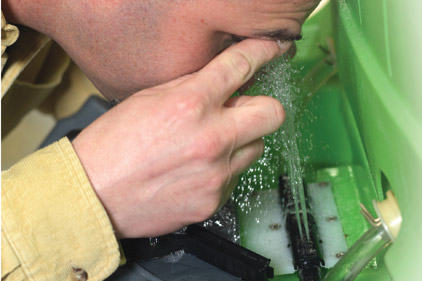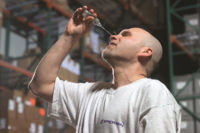Plus, 10 percent to 20 percent of all workplace eye injuries result in temporary or permanent vision loss according to OSHA. Protecting the eyes with safety eyewear is the best defense against injury, but accidents still happen.
When the eyes come in contact with dangerous or irritating chemicals, flushing them immediately with emergency eyewash is the single most effective way to remove harmful substances and to ensure the best possible outcome.
The American National Standards Institute calls for primary eyewash to be available within a 10-second walk of harmful materials and for the eyes to undergo a continuous 15-minute flush. If eyewash is not administered immediately, safely and properly, the risk of permanent damage increases significantly.
Consider that the cost of occupational eye injuries to employers averages $467 million per year, according to the U.S. Bureau of Labor Statistics. It is therefore important that employers and employees alike are knowledgeable about eyewash standards and safe practices to minimize the associated risk and costs. This article answers common questions about emergency eyewash to help guide successful practices in any workplace environment.
Q: How do I determine whether my site requires emergency eyewash?
A: The ANSI Z358.1-2009 standard for emergency eyewash and shower equipment calls for eyewash to be present at the site of any hazardous material that can cause adverse effects on an individual’s health and safety. To determine whether your worksite requires emergency eyewash, conduct a thorough walkthrough to assess the tasks performed and their related hazards. If flying objects, splashing chemicals, harmful vapors or liquids, or heavy dust are potential hazards, eyewash is likely required. Once the walkthrough is complete, consult ANSI and OSHA guidelines as well as manufacturers’ material safety data sheets (MSDS) to confirm whether eyewash must be present.
Q: Where should primary eyewash be located?
A: ANSI calls for emergency eyewash to be available for immediate use within a 10-second walk from the hazard. Since an injured worker’s vision will likely be impaired, the travel path must be free of obstructions and on the same level as the hazard, and the eyewash area should be clearly marked and well lit. In the case of corrosive chemicals such as strong caustics and strong acids, eyewash should be placed adjacent to the hazard.
Q: What kind of primary eyewash is right for my site?
A: There are two kinds of primary eyewash devices: plumbed and portable. Plumbed eyewash is capable of providing copious amounts of fluid. Plumbed units are also expensive to install, tough to move and require maintenance to remove sediment build-up. The temperature of the tap water used is not easily regulated and may become too hot or too cold to permit a safe 15-minute flush. Because tap water is not buffered or pH balanced, it can cause further irritation.
Alternatively, portable stations contain water, saline solution or 100 percent sterile saline. Buffered saline solution more closely matches natural tears and ensures safer flushing, while sterile saline offers unmatched safety because it is pH balanced, buffered and completely devoid of impurities. Since fluid stored in a portable unit is maintained at room temperature, tepid delivery is almost always assured, and portable units require far less frequent maintenance. In fact, sealed cartridges have up to a 24-month shelf life.
Q: Are there special considerations for eyewash that is exposed to extreme temperatures?
A: ANSI calls for flushing fluid to be delivered at a tepid temperature ranging between 60°F and 100°F to safely treat eyes without causing further injury or discomfort. In environments with extreme temperatures, it is important that the eyewash station be protected to ensure tepid fluid delivery. In outdoor settings, locate eyewash out of direct sunlight. If this is not possible, look for a solar shield accessory to minimize heating. For extreme cold applications, look for products that are freeze-rated, which keep fluid from freezing in temperatures as low as -32°F, or those with heated accessories that both keep fluid from freezing in temperatures as low as -40°F and maintain a tepid temperature. Remember: primary eyewash units must require only one hand to activate; putting any covering on a unit that is not specifically intended for the eyewash unit will hinder activation.
Q: How can we protect eyewash in dusty, dirty environments?
A: In workplaces with high levels of dirt, dust and particulate matter, equipment and even safety apparatus can become covered in dust and debris. In high particulate environments, a dust cover is a must. Be sure to select a dust cover from the eyewash manufacturer to ensure proper single-handed activation.
Q: What about irritants in the workplace that don’t need primary eyewash?
A: When nuisance particles such as dust, smoke, pollen or other irritants exist in locations where primary eyewash is not required, secondary eyewash bottles are an ideal solution. Highly portable, these bottles can be located at the site of any hazard — they can even be carried on the individual. Furthermore, in the case of chemical or caustic eye injury, secondary eyewash bottles provide immediate treatment en route to a primary eyewash unit as well as continuous irrigation on the way to medical care.
Q: How can we discourage employees from tampering with eyewash stations?
A: Numerous false activations can add up to a significant expense for employers. Curiosity is a leading reason why workers tamper with eyewash stations, and the best way to satisfy that curiosity is through education. One approach is to show training videos which detail installation, usage and maintenance. Another is to purchase an extra cartridge and activate the eyewash for everyone to see how it works firsthand. Whichever approach you choose, eyewash training should be conducted whenever a new hire begins, as well as during annual employee safety training.
Fostering increased familiarity with eyewash stations will serve your company well in the case of an eye injury. Not only do eyewash compliance and proper usage help to reduce costs and improve outcomes, but they play a role in supporting a company’s overall culture of safety. The result is a safe and productive workforce — an employer’s most valuable asset of all.

